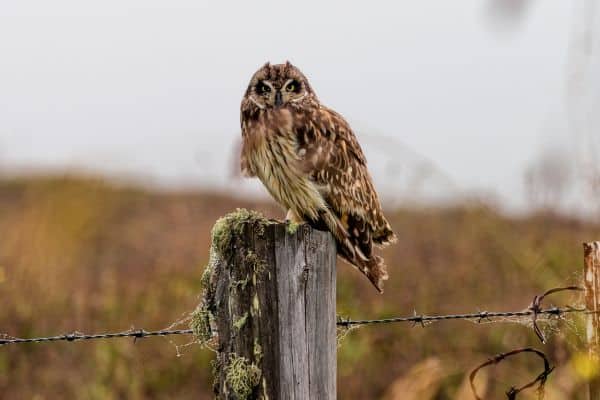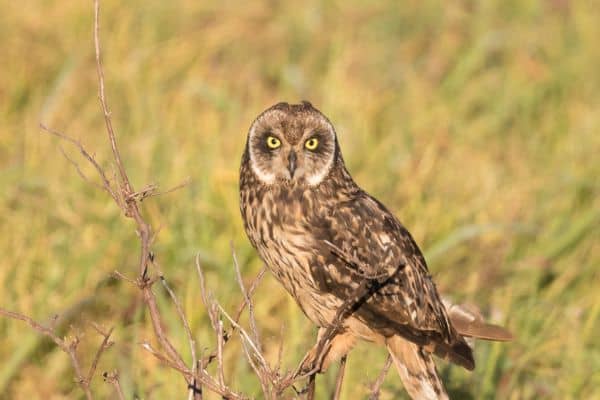Common Name: Pueo
Scientific Name: (Asio flammeus sandwichensis)| Size | Diet | Range in Hawaii | Status in Hawaii |
|---|---|---|---|
| 13 in. - 17 in. | mice, rats, shrews, and rabbits | Common on all islands | Endangered |
The Pueo (Asio flammeus sandwichensis) is a unique and mysterious bird of prey that is native to Hawaii. With its distinctive yellow eyes and brown feathers, this owl is a symbol of wisdom and grace in Hawaiian culture.
Although it is not found anywhere else in the world, the Pueo is a common sight on the islands, making it an important part of Hawaii’s natural heritage. In this article, we’ll explore the fascinating world of the Pueo and learn more about its unique adaptations and behavior.
Pueo
Appearance

The Pueo also known as the Hawaiian Short-eared Owl, is a distinctive bird species with a notable appearance. It measures approximately 13 to 17 inches in length, making it a medium-sized owl.
The Pueo has striking yellow eyes that contrast with its dark facial disc, which gives it an intense and captivating gaze. Its plumage varies in color, ranging from shades of brown to gray, helping it blend in with its surrounding habitat. The Pueo has long, slender wings and a short tail.
Diet
The Pueo has a diverse diet that reflects its adaptability as a predator. Its primary food source consists of small mammals such as mice, rats, shrews, and rabbits. Additionally, the Pueo preys upon various birds, including native and introduced species found in Hawaii.
It is also known to feed on insects, reptiles, and occasionally amphibians. The Pueo hunts primarily at night, using its exceptional hearing and keen eyesight to locate and capture its prey. This owl species plays a crucial role in maintaining the balance of its ecosystem by controlling populations of rodents and other small animals.
Nesting
The Pueo nests on the ground or in low vegetation, making it unique among owl species. It constructs nests by scraping out shallow depressions in the soil or utilizing existing natural cavities, such as hollowed-out tree stumps or rocky crevices.
The female Pueo lays a clutch of eggs, usually ranging from 3 to 6 in number, and both parents take turns incubating them. The incubation period lasts for approximately 26 to 33 days.
Once the eggs hatch, the parents care for the young, providing them with food and protection. The Pueo’s nesting behavior is adapted to the Hawaiian landscape, and it demonstrates the species’ ability to adapt and thrive in diverse habitats throughout the islands.
Behavior

The Pueo exhibits intriguing behaviors that are characteristic of its species. It is primarily a nocturnal hunter, taking advantage of the cover of darkness to search for prey. The Pueo is known for its exceptional low-flight hunting technique, gliding and hovering close to the ground in search of small mammals, birds, and insects.
It has keen hearing and vision, enabling it to locate and capture its prey with precision. The Pueo is also a territorial species, defending its nesting and foraging areas from intruders, particularly other owls.
It communicates through a range of vocalizations, including hoots, screeches, and hisses. During the breeding season, courtship displays involve aerial flights and calling to attract mates. The Pueo’s behavior reflects its adaptability and survival strategies in the unique Hawaiian environment.
Habitat
The Pueo is adaptable to a variety of habitats found across the Hawaiian Islands. It can be found in diverse ecosystems, including grasslands, shrublands, open agricultural areas, and even urban environments.
The Pueo’s preferred habitat often consists of areas with a mixture of open spaces for hunting and perching, as well as nearby vegetation for nesting and roosting. It is well-suited to both lowland and upland regions, and its presence can be observed from sea level to higher elevations.
The Pueo’s ability to adapt to different habitats demonstrates its flexibility and resilience in finding suitable environments for hunting, nesting, and raising its young in the unique landscape of Hawaii.
Range
The Pueo is a subspecies of the Short-eared Owl that is endemic to the Hawaiian Islands. It can be found on the major eight islands of Hawaii, namely Hawai’i (Big Island), Maui, Moloka’i, Lana’i, Kaua’i, O’ahu, Ni’ihau, and Kaho’olawe. The Pueo has adapted to various habitats within this range, including grasslands, shrublands, agricultural areas, and even urban environments.
This owl species plays an important role in the Hawaiian culture and is considered a significant symbol and protector. Efforts are being made to conserve the Pueo and its habitat across the Hawaiian Islands.
Conservation Status

The conservation status of the Pueo is a matter of concern. This owl species is currently listed as endangered by the International Union for Conservation of Nature (IUCN). The main threats to its population include habitat loss, degradation, and fragmentation due to urbanization, agriculture, and invasive plant species.
Predation by introduced mammals, such as rats and cats, also poses a significant threat. Additionally, collisions with vehicles and power lines contribute to the decline of Pueo populations.
Conservation efforts are underway to protect and restore the Pueo’s habitat, mitigate threats, and raise awareness about its importance as an endemic species in the Hawaiian Islands. The implementation of conservation measures, including habitat preservation and predator control, is crucial for the long-term survival of the Pueo.
Interesting Facts
1. Diurnal and nocturnal
The Pueo is known to exhibit both diurnal (active during the day) and nocturnal (active during the night) behavior, making it adaptable to different hunting conditions.
2. Exceptional hunting skills
With its low-flight hunting technique and acute senses, the Pueo is a skilled hunter, capable of locating and capturing prey with precision.
3. Wide distribution
The Pueo can be found on all major Hawaiian Islands, showcasing its adaptability to various ecosystems and habitats.
4. Endemic species
The Pueo is a subspecies of the Short-eared Owl that is endemic to the Hawaiian Islands, making it unique to this region.
Frequently Asked Questions
1. Are Pueos territorial birds?
Yes, Pueos are territorial birds, defending their nesting and foraging territories from other owls and potential intruders.
2. How does the Pueo communicate?
The Pueo communicates through a range of vocalizations, including hoots, screeches, hisses, and various other calls, which are used for territorial defense, courtship displays, and communication with its young.
3. Can the Pueo be kept as a pet?
No, it is illegal to keep native Hawaiian birds like the Pueo as pets without proper permits. It is essential to respect and protect these species in their natural habitats.
4. Can I see Pueos in the wild?
While sightings of Pueos in the wild are possible, they can be elusive and blend into their surroundings. It is essential to respect their space and observe them from a distance to avoid causing stress or disturbance




